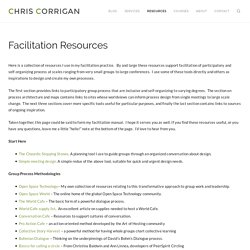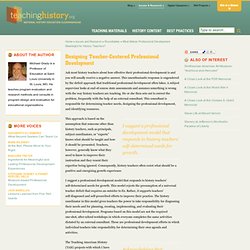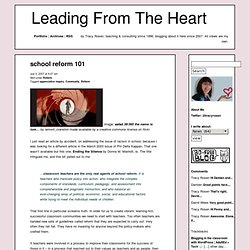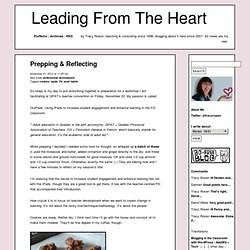Zoom
Trash

Facilitation Resources. Here is a collection of resources I use in my facilitation practice.

By and large these resources support facilitation of participatory and self-organizing process at scales ranging from very small groups to large conferences. I use some of these tools directly and others as inspirations to design and create my own processes. The first section provides links to participatory group process that are inclusive and self-organizing to varying degrees. The section on process architecture and maps contains links to sites whose worldviews can inform process design from single meetings to large scale change. The next three sections cover more specific tools useful for particular purposes, and finally the last section contains links to sources of ongoing inspiration. Taken together, this page could be said to form my facilitation manual. Consulter les ressources. Interesting conversation about teaching and technology
Designing Teacher-Centered Professional Development. Ask most history teachers about how effective their professional development is and you will usually receive a negative answer.

This unenthusiastic response is engendered by the deficit approach that traditional professional development often takes. A subject supervisor looks at end-of-course state assessments and assumes something is wrong with the way history teachers are teaching. He or she then sets out to correct the problem, frequently with the help of an external consultant. This consultant is responsible for determining teacher needs, designing the professional development, and identifying resources. I suggest a professional development model that responds to history teachers’ self-determined needs for growth. This approach is based on the assumption that someone other than history teachers, such as principals, subject coordinators, or “experts” knows what should be taught and how it should be presented.
Teacher-Centered Professional Development. It's true that students gain more from learning experiences when they're encouraged to plan their activities, share their knowledge with one another, and tailor material to their own needs.

So why not create a professional development program that gives teachers the same range of options? This book provides the framework and steps to help teachers: (1) Choose the right professional development strategies for their needs; (2) Collaborate with their peers in mentoring, journal writing, peer coaching, action research, and other activities; (3) Plan and schedule professional development events and experiences; and (4) Evaluate the effect of their efforts. The book includes checklists and assessment forms to make it easier to implement the guide's teacher-centered approach. Association for Supervision and Curriculum Development (ASCD), 1703 North Beauregard Street, Alexandria, VA 22311.
Tel: 800-933-2723 (Toll Free); e-mail: books@ascd.org. Leading From The Heart. Image: aafad 38/365 the name is lom… by lamont_cranston made available by a creative commons license on flickr.

I just read an article by accident, on addressing the issue of racism in school, because I was looking for a different article in the March 2003 issue of Phi Delta Kappan. That one wasn’t available but this one, Ending the Silence by Donna M. Marriott, is. The title intrigued me, and this bit yelled out to me: …classroom teachers are the only real agents of school reform. That first line in particular screams truth. If teachers were involved in a process to improve their classrooms for the success of those in it – in a process that reached out to their values as teachers and as people, then there will be true reform. Leading From The Heart. So today is my day to pull everything together in preparation for a workshop I am facilitating at QPAT’s teacher convention on Friday, November 23.

My session is called: OurPads: Using iPads to increase student engagement and enhance learning in the FG classroom. **Adult education in Quebec is rife with accronyms. QPAT = Quebec Provincial Association of Teachers. FG = Formation Géneral in French, which basically stands for general education. While prepping I decided I needed some food for thought, so whipped up a batch of these (I used the molasses and butter, added cinnamon and ginger directly to the dry, and threw in some raisins and ground nuts/seeds for good measure.
I’m realizing that the secret to increase student engagement and enhance learning lies not with the iPads, though they are a great tool to get there. Chris Casal - The Teacher-Centered iPad Deployment. Mobile Home Bloggers Messages Resources Tw | Fb | In | Rss Chris Casal The Teacher-Centered iPad Deployment , Technology Instructor & Coordinator , 11/15/2012 Bio Email This Print Comment 18 comments The last few years have seen a boom in the idea, terminology, and philosophy of the "student-centered" or "child-centered" classroom, but sometimes that model doesn't make sense.

When the iPad was first released, my principal wanted to order 100 of them. It's not that I didn't want them, but I wanted to have a plan for how we would use them before they became a hundred Angry Bird, $500 glorified paperweights. So, what was the plan? By why not more? So we bought four. And once those 20 were out in the wild?
By the end of the second year of the iPad's existence, all but three teachers out of 60 wanted, and got, an iPad.